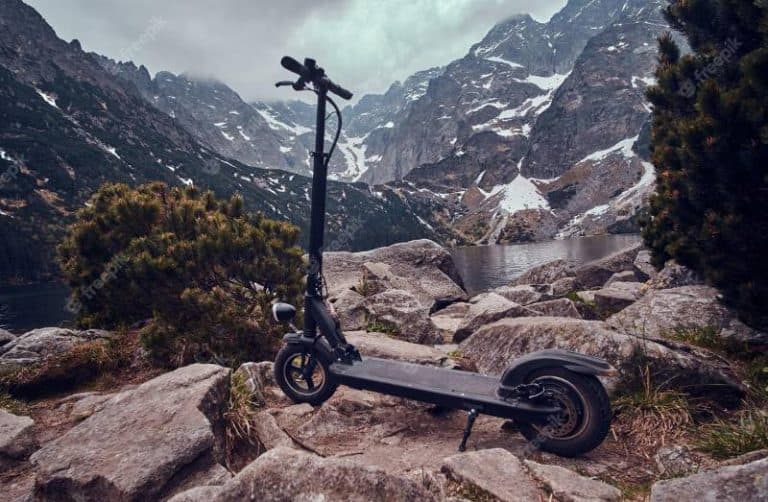Why Your Wallet Loves Electric Scooters Over Cars
Are you looking to save money while still being able to get around easily? An electric scooter may be the perfect option for you – not only are they environmentally friendly, but they can also mean huge savings on transport costs. By reducing the amount of time spent in a car commuting and taking advantage of shared or personal e-scooters, people everywhere have experienced major cost savings as well as improved convenience.
In this blog post, we’ll take an in-depth look at how using an electric scooter over a car can save you both time and money – from parking fees to fuel expenses and more! Read on to learn all about what financial benefits come with choosing an electric scooter for your next ride.
According to a survey conducted by Neuron Mobility, approximately one-third of car journeys were replaced by e-scooters. The survey also revealed that 60 percent of riders choose to combine their e-scooter trips with the use of public transportation. These findings indicate a growing preference among commuters for electric scooters as a mode of transport, surpassing the popularity of cars.
Key Takeaways
- Electric scooters offer significant cost benefits, from initial purchase and maintenance to fueling and indirect expenses like parking.
- Using electric scooters substantially reduces emissions and road wear, positioning them as a sustainable urban mobility option.
- While they have limitations, electric scooters provide immense value for short-distance commutes, saving time, money, and the environment.

Understanding the Electric Scooter
The evolution of technology, advancements in material sciences, enhancements in ride comfort, growing awareness about climate change, and a focus on sustainability have significantly fueled the demand for electric commuter vehicles in recent years.
But what powers these e-scooters?
At their core, electric scooters rely on four primary components: a battery, a motor, a throttle, and a controller. Among these, the battery and the motor serve as the heart and soul of the e-scooter’s operation.
Initiating a ride is as simple as twisting the scooter’s throttle. Upon doing so, the controller springs into action, instructing the battery to supply electricity to the motor, situated within the wheel hub. This motor then uses this influx of energy to turn its gears, propelling the scooter forward.
In essence, some e-scooters mimic their manual counterparts, requiring an initial manual kickstart, complemented by the twist of a throttle, to activate the motor. Their direction is controlled using handlebars, and they come to a halt when brakes are applied. The speed, meanwhile, can be regulated through the throttle.
While this provides a general insight, it’s essential to recognize that there’s no one-size-fits-all for e-scooters. Variations in design and features abound.
Now, let’s delve deeper into one of the pivotal components: the battery.
Battery
The battery’s role in an electric scooter is paramount. Its capacity and efficiency dictate the scooter’s range and overall performance on a single charge.
Three primary battery types power e-scooters:
- Nickel Metal Hydride (NiMH)
- Lead-Acid
- Lithium-ion
Nickel Metal Hydride (NiMH) Battery
Sitting between the older lead-acid and the contemporary lithium-ion, NiMH batteries are notable for their longer charge retention than lead-acid ones. However, they are bulkier when compared to lithium-ion batteries.
Lead-Acid Battery
Despite being a tad bulky for day-to-day applications, lead-acid batteries have a longstanding reputation in rechargeable devices owing to their affordability. They have been the trusted power source for vehicles like golf carts and certain cars and are frequently found in vintage scooter models.
Lithium-ion batteries represent the pinnacle of modern e-scooter power sources. Their compact size, lighter weight, environmentally-friendly nature, enhanced power, and superior charge retention make them stand out. Their evolution has, in many aspects, been instrumental in propelling the growth and popularity of electric scooters and bikes.
Direct Cost Comparisons
1. Initial Purchase
Electric Scooters:
- Price Range: The price of electric scooters varies depending on the brand, battery capacity, and other features. As of 2021, decent entry-level models start from $300 to $500, mid-range models can be anywhere from $600 to $1,200, and high-end models with long-range and other advanced features can cost $1,500 and up.
- Additional Costs: Protective gear (like helmets), possible licensing or registration in some areas.
Cars:
- Price Range: Even the most affordable new cars start from around $15,000 to $20,000. Used cars can be significantly cheaper, but the price varies based on age, model, mileage, and condition.
- Additional Costs: Licensing, registration, initial taxes, possible extended warranties, and immediate maintenance for used vehicles.
2. Maintenance
Electric Scooters:
- Routine Maintenance: Occasional tire replacements or inflations, brake checks, and battery replacements after a few years.
- Cost: Maintenance for electric scooters is generally quite low. Annually, one might spend anywhere from $50 to $150 depending on usage.
Cars:
- Routine Maintenance: Oil changes, brake replacements, tire rotations and replacements, air filter changes, spark plug replacements, and periodic checks of other systems like transmission and cooling.
- Cost: Maintenance costs for cars vary based on the car model and how it’s driven. However, the average driver might spend between $500 to $1,000 annually. For luxury or older models, this can be higher.
3. Fuel (Electricity vs. Gasoline)
Electric Scooters:
- Fuel Type: Electricity
- Cost: Charging an electric scooter typically costs pennies per charge. For example, if an electric scooter has a 500Wh battery and the local cost of electricity is $0.10 per kWh, a full charge would cost about $0.05.
- Annual Expense: If you charge the scooter daily, the total annual cost would be under $20.
Cars:
- Fuel Type: Gasoline (or diesel in some models)
- Cost: As of 2021, the average gasoline price in the U.S. fluctuates around $2 to $4 per gallon, depending on location and time of year.
- Annual Expense: Considering the average car mileage of 25 miles per gallon and a daily drive of 30 miles, a driver might consume about 12 gallons a month, leading to an annual fuel expense of $288 to $576 at $2 to $4 per gallon, respectively.
Indirect Cost Comparisons
Navigating the world of transportation costs isn’t just about the obvious stuff like how much you initially pay or how much it costs to keep your vehicle running. There’s a whole array of hidden, or rather indirect, costs that quietly eat into your wallet. Let’s journey together through these indirect costs and uncover the truths hidden behind parking fees, insurance costs, and the ever-mysterious depreciation.
1. Parking Fees
Electric Scooters:
Ah, electric scooters! These nifty little wonders are like the chameleons of the urban jungle. Why, you ask? Well, their compact size allows them to seamlessly blend into any environment. Think about it: you can easily roll them into your office, place them under your desk, or tuck them in a corner at your favorite cafe. No need to worry about parking fees, and absolutely zero stress about finding a parking spot during those busy downtown rushes. More often than not, the world is your parking spot!
Cars:
Now, cars, they’re a bit more demanding. Imagine trying to navigate through tight lanes on a bustling Friday evening, your eyes peeled for that elusive parking space, only to find one with a hefty parking fee attached. Cities are notorious for their premium parking charges. For instance, in major cities like New York or San Francisco, an hour of parking can set you back $5 to $10, or even more. Monthly parking fees? They can be upwards of $300 in some urban areas. And let’s not forget those pesky parking tickets when we accidentally overstay or misread a sign.
2. Insurance Costs
Electric Scooters:
When it comes to electric scooters, insurance is typically a breeze. In many regions, insurance isn’t even mandatory for e-scooters. But if you decide to be extra cautious and opt for insurance, the premiums are generally pocket-friendly, often ranging from $5 to $20 per month. It’s like treating yourself to an extra coffee or two.
Cars:
With cars, insurance is a whole different ball game. They come with mandatory insurance requirements in most places, and the stakes are high. Depending on factors like the car’s make, model, your driving record, and the region you live in, annual car insurance can range from $600 to $2,000 or more. It’s almost like signing up for a monthly subscription to, well, owning a car!
3. Depreciation
Electric Scooters:
Here’s a fun fact: electric scooters hold their value reasonably well, given their rising popularity. Yes, there’s depreciation, but it’s gentle on the pocket. Let’s say you bought a scooter for $1,000. After a year of zipping through streets and turning heads, it might still fetch you $700 or $800 when reselling. That’s not a steep drop, is it?
Cars:
Cars and depreciation share a bittersweet love story. The moment you drive a brand-new car off the dealership lot, it loses a chunk of its value. In fact, during the first year itself, a car can lose about 20% to 30% of its value. So, your shiny $20,000 car? By the end of year one, it might be worth just $14,000 to $16,000. And this depreciation continues year after year, making cars one of the fastest-depreciating assets one can own.
Environmental & Health Benefits
In our ever-evolving world, it’s more crucial than ever to make decisions that benefit both us and our planet. As the adage goes, “We do not inherit the earth from our ancestors; we borrow it from our children.” With this in mind, let’s dive deep into the environmental and health benefits of electric scooters, and see how they stack up against cars.
1. Reduced Emissions
Electric Scooters:
Electric scooters are the whispering maestros of the urban landscape. Why? Because they’re incredibly silent about their eco-friendliness. These scooters produce zero tailpipe emissions, which means cleaner air and fewer greenhouse gases entering our atmosphere. Given that transportation accounts for a significant percentage of global carbon emissions, choosing an e-scooter is akin to giving our planet a gentle hug.
Cars:
Even with advancements in fuel efficiency and the rise of electric cars, traditional gasoline-powered cars still emit a substantial amount of carbon dioxide and other harmful pollutants. Over its lifespan, a single car can release tonnes of carbon into the atmosphere, contributing to global warming and affecting air quality.
2. Less Road Wear and Tear
Electric Scooters:
Imagine a ballet dancer tiptoeing across a stage—that’s an electric scooter on the road. Their lightweight nature means they exert minimal stress on our roads, reducing the need for frequent maintenance and repairs. This not only preserves infrastructure but also minimizes the environmental impact of road construction, which involves energy-intensive processes and the use of asphalt, a petroleum product.
Cars:
Cars, on the other hand, are like a full-throttle tap dance performance. Their weight and frequent use cause wear and tear on our roads. This leads to regular road repairs, resurfacing, and the eventual replacement of road sections, all of which have an environmental footprint.
3. Health Benefits of Scooting
Electric Scooters:
While e-scooters might provide a powered ride, they still encourage more physical activity than sitting in a car. Riders engage their core muscles for balance, employ leg muscles when kick-starting, and enjoy the cardiovascular benefits of being outdoors. Plus, scooting can be a stress-reliever, allowing riders to enjoy the open air and navigate cityscapes seamlessly.
Cars:
Driving a car, especially during peak hours, can sometimes be a sedentary and stress-inducing activity. Traffic jams, tight parking spots, and the general hustle and bustle can contribute to elevated stress levels, which aren’t great for heart health or overall well-being.
Practicality & Limitations
Electric scooters have zipped their way into the mainstream, with more and more urbanites swapping their car keys for scooter handles. However, every silver lining has a cloud. While e-scooters are undeniably practical in many scenarios, they also come with some limitations. Let’s explore both sides of this coin to help you make informed decisions for your daily commute.
1. Commute Distances Suitable for Scooters
Practicality:
Electric scooters shine the brightest when navigating short to medium-distance commutes, especially in congested urban areas. With a range of anywhere between 10 to 40 miles on a single charge for most models, e-scooters are fantastic for zipping across town, running errands, or even covering the last mile from a public transit station to your destination.
Limitation:
For longer commutes, say over 40 miles round trip, an e-scooter might not be the most reliable choice. Even though some high-end models offer extended ranges, the time it takes to recharge and the possibility of draining the battery can make longer trips more challenging.
2. Weather Constraints
Practicality:
On sunny or mildly cloudy days, scooters are a joy to ride. They offer a refreshing way to enjoy the outdoors and feel the breeze as you navigate through city streets.
Limitation:
Weather can be an unpredictable beast. Heavy rain, snow, or even strong winds can make scooting uncomfortable, unsafe, or in some cases, impossible. Wet roads can be slippery, reducing traction, and electronic components, unless explicitly designed for it, might not appreciate a heavy downpour. Additionally, cold weather can impact battery performance, reducing your scooter’s range.
3. Storage Advantages
Practicality:
One of the standout features of electric scooters is their compactness. Unlike cars, which demand dedicated parking spaces, an e-scooter can be folded up and carried into offices, cafes, or even stored under a desk. This not only safeguards against theft but also eliminates parking woes. Imagine never having to circle a busy block looking for a parking spot again!
Limitation:
While they’re more compact than bicycles or cars, scooters are not entirely weightless. A typical electric scooter can weigh anywhere from 25 to 50 pounds or more. Lugging one up a flight of stairs or carrying it for extended periods might not be everyone’s cup of tea. Additionally, if the battery dies while you’re out and about, you’ll need some good old-fashioned foot power to keep it moving.
Real-Life Case Studies
Stories can provide powerful insights, especially when considering changes in daily routines and lifestyles. Here are a couple of real-life case studies of individuals who traded their car keys for scooter handles and the impact it had on their wallets and overall lifestyles.
1. Sarah: The Urbanite Professional
Before the Switch:
Sarah, a 28-year-old graphic designer, was living and working in downtown San Francisco. Every day, she would navigate her way through the city’s notorious traffic, searching for parking spots and spending heavily on fuel and parking fees. Annually, she was spending roughly:
- Gasoline: $1,500
- Parking: $3,600 ($300/month in a city garage)
- Maintenance: $1,000
- Insurance: $1,200
Total: $7,300 annually
After the Switch:
Sarah decided to buy an electric scooter for her daily commutes and occasional errands. The scooter cost her $1,000 upfront. Her new annual expenditures included:
- Electricity: $50
- Maintenance: $100 (minor repairs and upkeep)
- Insurance (optional, but she took it): $120
Total: $270 annually (excluding the one-time scooter purchase)
Annual Savings: $7,030
Besides the evident financial savings, Sarah relished her stress-free commutes, no longer had to worry about parking, and felt more connected to her city, often discovering new cafes and local spots she’d previously overlooked.
2. Raj: The Suburban Dad
Before the Switch:
Raj, a 40-year-old IT consultant living in the suburbs of Austin, primarily used his car for both work commutes and family outings. His annual car-related expenditures were:
- Gasoline: $1,800
- Maintenance: $800
- Insurance: $1,500
Total: $4,100 annually
After the Switch:
Raj started using an electric scooter for his work commutes and saved his car for family trips. His scooter cost $900, and his subsequent annual costs were:
- Electricity: $60
- Maintenance: $80
Reduced Costs with Less Car Usage:
- Gasoline: $1,200 (saved $600 annually)
- Maintenance: $500 (saved $300 annually)
Total (including car expenses): $2,740 annually (excluding the one-time scooter purchase)
Annual Savings: $1,360
For Raj, the switch wasn’t just about saving money. It was also about embracing a healthier lifestyle. He lost some weight, felt more energized, and enjoyed his morning rides as they provided a refreshing start to his day. On weekends, he’d often go on longer rides, exploring trails and parks.

The Cost Savings of Using an Electric Scooter Over a Car FAQs
How long does an electric scooter last compared to a car?
The lifespan of an electric scooter heavily depends on the model you get, your usage frequency, and the maintenance it receives. Most models can last anywhere from 1 to 3 years with regular use. On average, cars can last up to 10 years or more depending on their condition and mileage.
What is the average range of an electric scooter on a single charge?
The average range of electric scooters on a single charge can vary anywhere from 10 to 40 miles depending on the model and battery size. Higher-end models might offer extended ranges, but these come at a higher cost.
Can electric scooters be used for long-distance commuting?
Electric scooters are designed primarily for short-distance commuting, such as the last mile from a public transit station to your destination. For longer commutes, an electric scooter might not be the most reliable choice due to its battery life and the time it takes to recharge. It’s best to check out the range of each model before making a purchase decision.
How do electric scooters impact the environment compared to cars?
Electric scooters are powered by electricity, so they produce zero emissions. This makes them extremely eco-friendly compared to cars, which rely on gasoline and produce carbon dioxide emissions. Additionally, electric scooters require less maintenance than cars and need fewer resources for production.
What are the insurance costs for electric scooters vs. cars?
Insurance costs for electric scooters vary depending on the insurer, model, and type of insurance you select. Generally speaking, riding electric scooters cost less than cars to insure as they are not legally required to be insured. However, it’s still a good idea to purchase some form of insurance coverage in case an accident or theft occurs.
Conclusion
Electric scooters have much to offer in terms of cost savings, sustainability, and convenience. From purchase prices to fuel costs, owning an electric scooter can make a substantial financial impact compared to using a car. On top of these monetary savings, electric scooters are also environmentally friendly, reducing emissions and road damage in congested cities.
Although they may not be suitable for every commute, electric scooters are great for those who need a fast and affordable way to get around town. Now is the perfect moment to take advantage of all that electric scooters offer us.
So don’t wait any longer: choose your electric scooter today and start saving money right away! And for the latest news on renewable energy options, like solar or wind power, and many other sustainability opportunities from around the world, subscribe to our newsletter at Electrik Living. We talk about living sustainably with real-time tips that make it easy for anyone!






